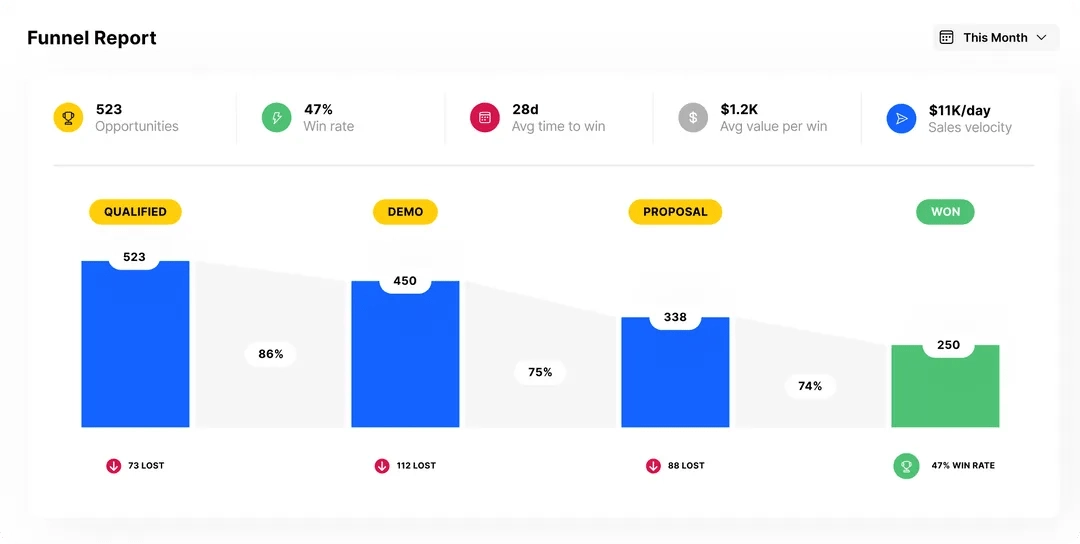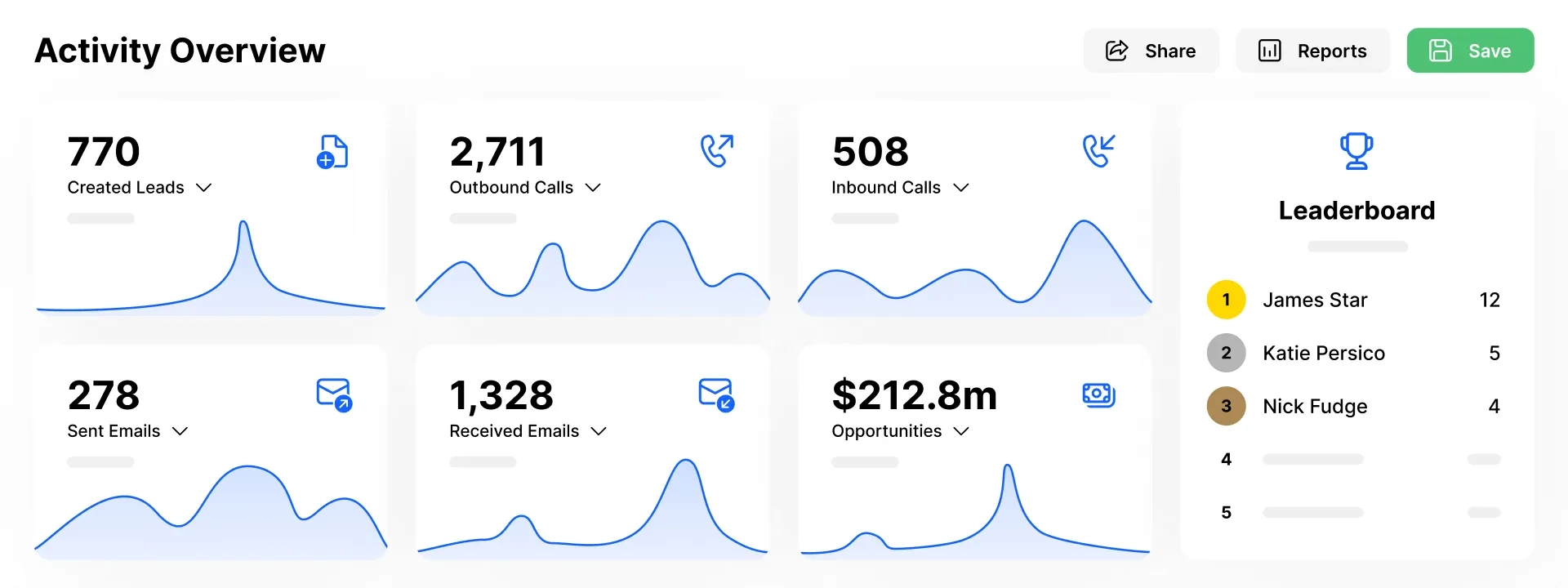
Gestión de la cartera de ventas: La guía completa y de confianza
Una pregunta para usted: ¿Está aprovechando al máximo su canal de ventas?
Un proceso de ventas, o una representación visual del proceso de ventas de una empresa, suele dividirse en diferentes secciones, desde la generación de clientes potenciales hasta la venta. Su objetivo es ayudar a los representantes de ventas a agilizar sus flujos de trabajo y convertir con éxito clientes potenciales en clientes.
Here's the thing: Most sales teams have a sales pipeline, but few of them know how to manage it effectively. In fact, sales pipeline management is one of the toughest tasks in sales.
Después de aprender las técnicas de esta guía, estará preparado para gestionar eficazmente su canal de distribución a largo plazo, sacándole el máximo partido ahora y en el futuro.
¿Qué es la gestión de la cartera de ventas?
Es tarea de los jefes y gerentes de ventas ocuparse del pipeline, asegurarse de que está actualizado y mejorarlo con el tiempo.
¿Por qué es tan importante?
Porque su proceso actual no le servirá de nada dentro de un año, ni dentro de cinco, ni dentro de diez. El mercado cambia constantemente y su proceso de ventas debe cambiar con él. Cuando eso ocurre, tu proceso debe adaptarse a las condiciones actuales.
When your pipeline is updated, improved, and cleaned over time, it allows reps to focus on selling and avoid getting lost in the noise of the pipeline. It also helps sales managers and leaders to see exactly what’s happening in the pipeline, where the most important deals are, and how their reps are performing at each stage.
Etapas del proceso de ventas
People have been identifying sales pipeline stages since the late 1800s. I'm not joking. John H. Patterson did it to help close deals for his company, National Cash Register, in 1887.
Hoy en día, la mayoría de los equipos de ventas dividen sus ciclos de ventas en siete etapas distintas:
- Prospecting: This stage is all about lead generation. Your sales and marketing teams should attempt to engage inbound and outbound prospects via tactics like cold calling, email, and SEO (search engine optimization), and link building prospecting. This kind of prospecting specifically targets high quality backlinks that can boost your site's authority and search ranking.
- Qualification: The next stage is all about prospect evaluation. Not every person is a good fit for your company's products and services. You need to identify the bad-fits early in the sales process and remove them from your sales pipeline.
- Initial Contact: Once you've eliminated bad-fit prospects, you move on to stage three. In this stage, your reps reach out to potential customers and attempt to build relationships with them. The most used messaging channels are phone and email.
- Meeting/Demo: Some prospects will want to learn more about your products/services. This is the perfect time to schedule meetings and/or product demos. This gives reps the opportunity to guide prospects toward a sale.
- Needs Analysis: After meeting with prospects, your reps should have a good idea of what they need. Reps can then decide if your products/services will help prospects reach their desired goals. If they will, reps can move to the next stage.
- Close: At this part of the sales process, potential customers are ready to make a decision. Will they buy from you or will they walk away? If your reps have properly qualified their leads, given good demos, etc., they should close the deal.
- Follow-Up: The first sale is not the end! Successful sales reps always prioritize following up. This allows reps to stay top-of-mind with prospects, ensure a smooth onboarding, ask for referrals, and otherwise increase the likelihood of future sales.
¿Por qué es importante la gestión de la cartera de ventas?
Una gestión adecuada de la cartera de ventas conduce a acuerdos más importantes y valiosos, a una mejor previsión y a una mayor velocidad de ventas. Veamos con más detalle estas tres ventajas.
Más ofertas
Proper sales pipeline management will help your team focus on quality leads that result in higher-value sales opportunities. Doing so will lead to greater company growth.
In fact, a recent Harvard Business Review study found that companies that prioritize pipeline management have an average growth rate of 5.3, a 15% increase.
Mejores previsiones de ventas
An effective pipeline management strategy will help your forecasting efforts, too.
¿Cómo? Podrá ver las métricas de actividad de cada miembro del equipo y las diferentes etapas en las que se encuentran sus clientes potenciales. A continuación, puede combinar estos datos para determinar cuántas ventas realizará su equipo de forma realista en los próximos 30, 60 o 90 días.
Saber cuántos ingresos generará su departamento de ventas en los próximos meses es esencial. Sin esta información, los responsables clave de la toma de decisiones en su empresa no tendrán la información que necesitan para dirigir su empresa hacia adelante de una manera eficaz.
Mayor velocidad de ventas
Por último, pero no por ello menos importante, una gestión adecuada de la cartera de ventas aumentará la velocidad de los acuerdos.
By minimizing your sales cycle length, you'll close deals faster, which means your reps will have more time to engage and build relationships with other prospects. This is especially important in B2B sales, where sales cycles are generally longer than in B2C sales.
Usted necesita rapidez, y una gestión adecuada de sus proyectos le ayudará a conseguirla.
5 aspectos de una gestión eficaz de la cartera de ventas
Ahora que ya sabe qué es la gestión de la cartera de ventas y por qué es importante, hablemos de cómo puede agilizar el proceso y mejorar sus flujos de trabajo.
This is probably a good point to pause and mention—managing and maintaining your pipeline is a lot easier with a robust, responsive CRM like Close. Check out our demo, and then carry on.
Estos cinco consejos le ayudarán a gestionar eficazmente su cartera de proyectos.
1. Crear y mantener un proceso de ventas claramente definido
To build an effective sales process, you must develop a collection of repeatable steps that your team can use to push leads through the pipeline and convert them into happy customers.
Cuando su proceso de ventas esté claramente definido, sus representantes comprenderán lo que debe ocurrir en cada etapa de su canal de ventas para evitar cuellos de botella.
Por ejemplo, puede que descubra que es necesario ajustar su proceso debido a un cambio en el mercado o en su producto. Puede que el recorrido del cliente haya cambiado y la forma en que las personas descubren su empresa o interactúan con ella haya cambiado. En estos casos, tendrá que ajustar las fases de su proceso de ventas para adaptarlo a las condiciones actuales del mercado y garantizar el crecimiento de los ingresos.
Sólo tiene que asegurarse de que siempre giren en torno a estas siete etapas principales del proceso:

Give your reps a solid map—and then encourage them to follow it.
2. Prever como un profesional
Su canal de ventas no debería implicar conjeturas. Para gestionar eficazmente tu equipo y las acciones que tienen lugar dentro de tu embudo de ventas, necesitas generar previsiones respaldadas por datos.
Nunca te preguntes qué va a pasar con tus ventas.
Para hacer previsiones como un profesional, haga un seguimiento de todo su proceso de ventas y de los objetivos específicos que ha fijado para su equipo. A continuación, ten en cuenta ciertos datos, como cuánto cuesta tu producto, cuánto gastas por cliente potencial, el mercado potencial y las próximas fluctuaciones de precio.
Por último, recopile datos sobre su cartera de proyectos y su tasa de éxito. ¿Hay fugas que deba tapar? ¿Con qué frecuencia se convierten las nuevas oportunidades en clientes de pago?
With this information and an effective CRM like Close, you’ll be able to translate this data into accurate forecasts. (Note: Different sales forecasting strategies are valuable to different teams. You’ll need to decide what kind of forecasting you need to reach your goals.)
3. Desayuna tus métricas clave
There are tons of important sales metrics that you need to be aware of.
Pero para gestionar con éxito su cartera de proyectos, sólo debe centrarse en las métricas que realmente importan a su proceso único. Evite perderse en un complejo torbellino de datos.
Algunas de las métricas clave que tendrás que vigilar son:
- Valor de la tubería
- Tamaño medio de las operaciones
- Velocidad de la cartera de ventas
- Índice de conversión por etapa
- Rendimiento de la cartera de ventas

These and other essential metrics will help you keep an eye on the health of your pipeline. They'll also give you real-time insights about where to make adjustments.
4. Implementar un seguimiento eficaz de los representantes de ventas
Supervisar las actividades de venta de sus representantes dentro del pipeline es esencial para gestionarlo con eficacia.
El trabajo del director de ventas es asegurarse de que se asigna el número correcto de operaciones a cada representante, de que se contacta con los clientes potenciales de forma oportuna (por teléfono, correo electrónico, redes sociales, etc.) y de que las oportunidades progresan de forma constante.
By monitoring your reps’ activities throughout the sales cycle, you’ll make sure everyone is playing an active part in building a sales process that wins.
5. Revisar periódicamente la cartera de ventas
El último aspecto de la gestión de la cartera de ventas es el proceso de revisión.
Schedule sales performance reviews every month or quarter, and use them to analyze and clean up your pipeline. How many deals did you lose last month? How many cold leads are cluttering up your pipeline? Which stage of the pipeline has the most leaks?
Analice los datos de que dispone para responder a estas preguntas. (Nota: las herramientas de gestión de pipeline como Close facilitan la evaluación del proceso de ventas).
You can also use your sales pipeline review meetings to talk with your reps about current deals that are on the table, especially the big fish in the pipeline. Together, your team can discuss obstacles and brainstorm ideas to close faster.
Cómo hackear el proceso de ventas con un software eficaz de gestión de pipeline
Para gestionar eficazmente su canal de ventas (¡y no perder el tiempo!), debe poner en marcha procesos y automatizaciones específicos. Así obtendrás la información que necesitas sin tener que rebuscar entre montones de datos.
Hablemos de cinco métodos para hackear el proceso de canalización de ventas y gestionarlo de forma más eficiente.
1. Utilice un CRM de canal de ventas para multiplicar por 10 las automatizaciones
Building your sales pipeline in a spreadsheet (like SalesTable) can work for small teams. But you can boost your productivity by using a CRM to track and organize data automatically.
Puede que seamos un poco parciales, pero creemos que Close es una de las mejores opciones para automatizar todo el proceso de canalización de ventas, desde las actividades de captación de clientes potenciales hasta el cierre de la venta.
For example, Close’s reporting features include an Opportunity Funnel report, which gives you all of the key sales pipeline metrics at a glance, including:
- Índices de conversión por etapa
- Porcentaje de victorias
- Velocidad de ventas
- Plazo medio de cierre
Get the information you need to make effective decisions—without wasting a huge amount of time in the process. Close will help you get eyes on your data fast.
2. Utilice plantillas de previsiones que se integren con sus datos
Elegir las herramientas y plantillas de previsión adecuadas le ayudará a gestionar mejor su cartera de pedidos. También te dará una visión más precisa de hacia dónde se dirige tu equipo de ventas.
Por ejemplo, si utilizas una plantilla de previsión de ventas que se puede convertir en una hoja de Google, puedes integrarla fácilmente con otras herramientas y puntos de datos mediante Zapier. ¡Gana!
3. Combine los datos de actividad de los representantes y las tasas de conversión de las canalizaciones para planificar con mayor eficacia
Saber exactamente qué están haciendo sus representantes en cada fase del proceso de ventas es sólo una parte de una estrategia de gestión de pipeline de alto nivel.
Cuando combines esta información con otros datos relevantes, podrás ver el futuro (¡sin la ayuda del Delorean de Doc!).
Empiece por comparar los datos de actividad de los representantes en una etapa concreta con sus tasas de conversión.
Por ejemplo, en la fase de cualificación, ¿qué actividades conducen a conversiones? ¿Los representantes que se centran en llamar cierran más tratos que los que sólo envían correos electrónicos? ¿O hay una combinación de contactos telefónicos y por correo electrónico que conduce a un mayor número de conversiones?
Para responder a preguntas como éstas, dedique tiempo a analizar los datos de cada etapa. A continuación, utiliza dichos datos para extraer conclusiones precisas y anótalas. Por ejemplo, puede que descubras que
- Se necesitan al menos 4 contactos para conseguir una reunión con un cliente potencial
- Las demostraciones funcionan mejor que las presentaciones de ventas el 74% de las veces
Una vez obtenidas estas conclusiones, puedes entrenar a tus vendedores para que realicen las acciones correctas en los momentos adecuados. Con Close, por ejemplo, puede hacer un seguimiento de la actividad de los representantes e incluso establecer una clasificación. Los representantes que realicen más acciones objetivo subirán puestos en la clasificación.

These conclusions will also help you forecast more effectively. If you know that it takes an average of three follow-ups to finalize negotiations, for instance, you can more accurately predict the amount of time it will take to close new leads.
4. Integrar diferentes herramientas para realizar un seguimiento automático de los KPI adecuados
Su CRM es un gran lugar para recopilar datos importantes. Pero no es la única herramienta que utilizará para recopilar información y analizar métricas durante el proceso de gestión de oportunidades.
Si quieres tenerlo todo en orden, tendrás que crear un sistema para automatizar la recopilación de datos importantes y reunirlos en una ubicación central. Así no tendrás que estar comprobando diferentes herramientas y sistemas para encontrar los datos que necesitas.
Por eso nos encantan las integraciones en Close. Al integrar tus herramientas de recopilación de datos favoritas, puedes reunir datos relevantes basados en el puñado de métricas esenciales que elegiste para tu equipo.
Una vez que sepas qué métricas necesitas controlar, haz una lista de las herramientas que necesitas utilizar.
Empiece por su CRM. Aquí es donde recopilará datos sobre sus clientes, abrirá nuevas oportunidades y verá la actividad de los representantes.
A continuación, añada otras herramientas. Por ejemplo, ¿utilizas herramientas de comunicación con el cliente como Drift, MailChimp o Zendesk? ¿Y herramientas de análisis como Gong o Google Analytics?
Una vez que tengas esta lista, busca la forma de integrar todas estas aplicaciones.
Since Close CRM integrates natively with all of the tools mentioned above, you can collect and analyze in-depth data with no trouble at all.
If you want, you can feed your data into a Google Sheet, or you can display it visually using a tool like Geckoboard.

With this tool, you can create your own custom dashboard with information from various sources; then, display it for your reps to see. You can use Zapier to link Geckoboard to almost any tool you want, including Close.

By analyzing, organizing, and integrating your data across different tools, you’ll save time and have a better point of view to manage your sales pipeline effectively.
5. Utilizar plantillas de canal de ventas para revisiones
Otra forma de mejorar la gestión de los proyectos es automatizar las reuniones de revisión.
Aunque las reuniones son una parte esencial de la gestión de la cartera de pedidos, prepararlas y asistir a ellas requiere un tiempo que los responsables de la toma de decisiones como usted podrían dedicar a otras tareas importantes, como analizar el rendimiento de los representantes y diseñar nuevas estrategias de ventas.
Para reducir el tiempo que dedica a las reuniones de revisión, utilice plantillas para automatizar los flujos de trabajo.
Por ejemplo, ¿por qué no crear una plantilla de orden del día? Así te asegurarás de que tus reuniones siguen un patrón similar, lo que ayudará a todo el mundo a mantener el rumbo. Si creas la plantilla del orden del día en Google Docs, todo tu equipo podrá colaborar y añadir sus puntos de discusión directamente en ella.
Este modelo de orden del día podría incluir puntos como
- Revisión de las medidas adoptadas en la última reunión
- Mencione las victorias de la última semana/mes
- Pida a los representantes que destaquen una o dos oportunidades que les entusiasmen o que les planteen dificultades y obtenga la opinión del equipo.
- Establecer acciones claras para cada representante durante la semana o el mes siguientes.
También puede utilizar paneles de métricas personalizados en estas reuniones. Por ejemplo, puede utilizar la vista Pipeline en Close para garantizar la representación visual de sus métricas, mientras discute las oportunidades actuales con su equipo. Esto ayudará a que las cifras sean más fáciles de entender.
Utilice este proceso de gestión de la cartera de ventas para mejorarla
Permítame preguntarle de nuevo: ¿Está aprovechando al máximo su canal de ventas?
Si sigue estos pasos para gestionar su canal de forma eficaz, podrá realizar un seguimiento de las métricas correctas, así como de las acciones de sus representantes. Esto te ayudará a optimizar al máximo tu pipeline.
¿Cómo? Sus representantes estarán mejor preparados para atender a los clientes potenciales cualificados en sus pipelines, y usted tendrá una visión más clara de sus ventas actuales y previsiones futuras.
If you’re ready to fully optimize your pipeline for your business, you need the right tools to get started. See how Close can help you create a streamlined pipeline for your business.











